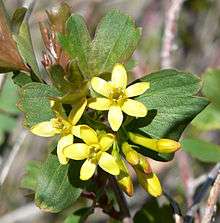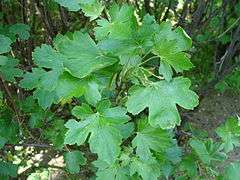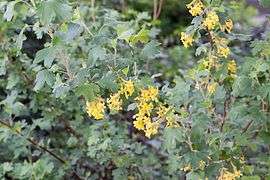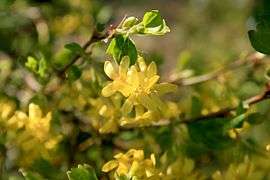Ribes aureum
| Golden currant | |
|---|---|
 | |
| Ribes aureum var. aureum, Spring Mountains, Nevada. | |
| Scientific classification | |
| Kingdom: | Plantae |
| Clade: | Angiosperms |
| Clade: | Eudicots |
| Order: | Saxifragales |
| Family: | Grossulariaceae |
| Genus: | Ribes |
| Subgenus: | Ribes subg. Ribes |
| Section: | Ribes sect. Symphocalyx |
| Species: | R. aureum |
| Binomial name | |
| Ribes aureum Pursh 1813 | |
| Synonyms[1] | |
|
List
| |
Ribes aureum, known by the common names golden currant,[2] clove currant, pruterberry and buffalo currant, is a species in the genus Ribes.[3] It is native to Canada, most of the United States (except the southeast) and northern Mexico. The variety Ribes aureum var. villosum is sometimes considered a full species, Ribes odoratum.[4][5]
It belongs to the subgenus Ribes, which contains other currants, such as the blackcurrant and redcurrant (Ribes nigrum and rubrum), and is the sole member of the section Symphocalyx.[6]
Description
Ribes aureum is a small to medium-sized deciduous shrub, 2–3 metres (6.6–9.8 ft) tall. Leaves are green, with 3 or 5 lobes, turning red in autumn.[7]
The plant blooms in spring with racemes of conspicuous golden yellow flowers, often with a pronounced, spicy fragrance similar to that of cloves or vanilla. Flowers may also be shades of cream to reddish, and are borne in clusters of up to 15.[8] The shrub produces berries about 1 centimeter (0.4 inch) in diameter from an early age. Ripe fruits, amber yellow to black, are edible raw, but very tart, and are usually cooked with sugar. The flowers are also edible.[8][7]
 Leaves
Leaves Ribes aureum shrub texture.
Ribes aureum shrub texture. Flowers
Flowers
Varieties
- Ribes aureum var. aureum: below 3,000 feet (910 m) in the western U.S.[9]
- Ribes aureum var. gracillimum: below 3,000 feet (910 m) in the California Coast Ranges[10]
- Ribes aureum var. villosum—clove currant (syn: Ribes odoratum); native west of Mississippi River, but naturalized further to the east[5]
Uses
Cultivation
Ribes aureum is widely cultivated as an ornamental plant, in traditional, native plant, drought tolerant, and wildlife gardens, and natural landscaping projects.[11] Unlike some other species of currants, Ribes aureum is in the remarkably drought-tolerant group of Ribes. Named cultivars have been introduced also.
Culinary and medicinal
Golden currant is also planted for the edible berries. Although flowers are hermaphroditic, the yield is greatly benefited by cross-pollination.
The berries were used for food, and other plant parts for medicine, by various Native American groups across its range in North America.[8][12]
Diseases
- Rust host
This currant species is susceptible to white pine blister rust (Cronartium ribicola), a fungus which attacks and kills pines, so it is sometimes eradicated from forested areas where the fungus is active to prevent its spread.[8][13]
Description of cultivars
- Crandall: The oldest known cultivar. Large black berries 2 cm in size with a spicy and aromatic flavour. A late season cultivar that ripens once the berries are soft, not when they first turn black. Self-fertile.
- Idaho: Similar to Crandall but more vigorous and higher yielding.
- Gwens: Teardrop-shaped berries that ripen in a staggered fashion, meaning there are berries of many different colours on the bush.
- Venus (Венера): Drought-tolerant and pest resistant. High-yielding (8 kg per bush). Berries are 2-3 grams, black, very juicy, ripen early in the season and in a synchronised fashion.
- Lyaysan (Ляйсан): Small berries (1-2 grams) but very good tasting and golden-amber in colour. Vigorous but compact in growth. Mid-season.
- Shafak (Шафак): Disease resistant and frost resistant. Fruit are 1.5 to 3 grams, dark red, teardrop-shaped and ripen mid-season.
- Zarina (Зарина): An elite cultivar bred by GNU Bashkir Scientific Research Institute of Agriculture, Russia. Parents are Venus and Lyaysan. Berries average 2.5 grams in weight, have a sweet and superior taste, ripen mid-season and are golden-orange in appearance. High-yielding.
- Uzbek (Узбекистанская): Very large black berries (up to 7g) and high yielding. A hybrid currant that is very hardy.
- Seedless (Кишмишная): Black fruit with golden pulp that is sweet and juicy, averaging 1.5-2g. Bushes are compact, of medium growth and high yield (7–8 kg).
- Fatima (Фатима): The best tasting cultivar along with Zarina, but higher yielding. The black berries ripen early in the season.
- Seedless Raspberry (Кишмишная малиновая): Spreading and vigorous growth with a huge yield of 12 kg per bush. Berries are dark red and up to 4 grams.
References
- ↑ "Ribes aureum". World Checklist of Selected Plant Families (WCSP). Royal Botanic Gardens, Kew – via The Plant List.
- ↑ "Ribes aureum". Natural Resources Conservation Service PLANTS Database. USDA. Retrieved 22 October 2015.
- ↑ "Ribes aureum". Plants for a Future.
- ↑ "Ribes odoratum". Plants for a Future.
- 1 2 Morin, Nancy R. (2009). "Ribes aureum var. villosum". In Flora of North America Editorial Committee. Flora of North America North of Mexico (FNA). 8. New York and Oxford – via eFloras.org, Missouri Botanical Garden, St. Louis, MO & Harvard University Herbaria, Cambridge, MA.
- ↑ "Ribes aureum". Germplasm Resources Information Network (GRIN). Agricultural Research Service (ARS), United States Department of Agriculture (USDA).
- 1 2 Morin, Nancy R. (2009). "Ribes aureum". In Flora of North America Editorial Committee. Flora of North America North of Mexico (FNA). 8. New York and Oxford – via eFloras.org, Missouri Botanical Garden, St. Louis, MO & Harvard University Herbaria, Cambridge, MA.
- 1 2 3 4 USDA Species Profile
- ↑ Jepson Manual treatment for Ribes aureum var. aureum
- ↑ Jepson Manual treatment for Ribes aureum var. gracillimum
- ↑ Las Pilitas Nursery horticultural treatment: Ribes aureum . accessed 1.30.2013
- ↑ University of Michigan (Dearborn): Ethnobotany
- ↑ Marshall, K. Anna (1995). "Ribes aureum". Fire Effects Information System (FEIS). US Department of Agriculture (USDA), Forest Service (USFS), Rocky Mountain Research Station, Fire Sciences Laboratory – via https://www.feis-crs.org/feis/.
External links
| Wikimedia Commons has media related to Ribes aureum. |
- Jepson Manual Treatment — Ribes aureum
- United States Department of Agriculture Plants Profile: Ribes aureum (golden currant)
- University of Washington, Burke Museum
- Ribes aureum in the CalPhotos Photo Database, University of California, Berkeley
- line drawing for Flora of Pakistan